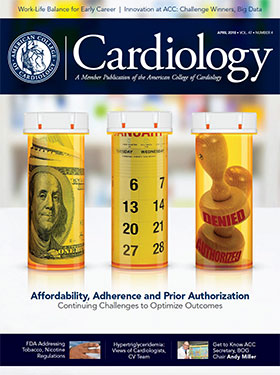Cover Story | Affordability, Adherence and Prior Authorization: Continuing Challenges to Optimize Outcomes

Affordability of medications and its role in adherence to prescribed treatments is back in the spotlight with the late-breaking ARTEMIS trial presented at ACC.18. The mortality reduction seen with the PCSK9 inhibitor alirocumab in the ODYSSEY Outcomes trial is welcome news. Yet, the high annual cost of treatment for the injectable drug is a barrier to treatment.
Indeed, on the same day the trial results were presented at ACC.18, the manufacturer announced a plan to reduce the price for alirocumab contingent on insurers and pharmacy benefit managers showing a greater willingness to reduce barriers to access. No specific price has been set, but the company said it would be in line with an updated analysis from the independent Institute for Clinical and Economic Review (ICER) that was released to coincide with the trial’s presentation.1
The preliminary assessment from ICER set an updated value-based price benchmark net of rebates and discounts for alirocumab between $2300 and $3400 per year if used to treat all recent acute coronary syndrome (ACS) patients who meet the trial’s eligibility criteria. Or between $4500 and $8000 per year if reserved for higher-risk patients with LDL-C ≥100 mg/dL despite intensive statin therapy.
ICER plans to publish a final cost-effectiveness update for alirocumab by May 3, 2018, but noted that this newest estimate does not alter their September 2017 assessment of evolocumab. That value-based assessment set a lower price range, from approximately $1,700 to $2,200, based primarily on FOURIER’s failure to demonstrate a statistically significant reduction in cardiovascular or all-cause mortality, nor a trend toward improved clinical benefit in patients with higher LDL-C levels.
While there’ll be much discussion in the weeks and months ahead about the cost of PCSK9 inhibitors and various cost effectiveness analyses will be published, along with defining the patients in whom it’s most cost effective, one thing remains clear. Even with a price reduction from the manufacturer and insurer willingness to pay, the out-of-pocket costs to the individual patient will be substantial. The copay can be as much as $3000. Navar and colleagues found that fewer patients with higher copays picked up their prescription after prior authorization was obtained, with 75 percent abandonment for a copay of $350 or more.2
 Margo B. Minissian, PhD, ACNP, AACC
Margo B. Minissian, PhD, ACNP, AACC
And for many of these patients, this is not the only drug they’re paying for each month. “This is a huge financial hardship for many of our patients, many of whom can be taking as many as 10 medications,” says Margo B. Minissian, PhD, ACNP, AACC. Moreover, discount cards and other financial assistance from the pharmaceutical company cannot be used for patients who have government-funded health insurance.
Do programs that address the patient’s cost for a drug improve adherence and outcomes? Well, yes and no. Eliminating the cost of the copay for the P2Y12 inhibitor led to more physicians prescribing the more potent but more expensive P2Y12 inhibitor and the rate of patient adherence at one year, a co-primary endpoint in the ARTEMIS trial. But, in these post ACS patients, there was no significant difference in the co-primary composite endpoint of myocardial infarction (MI), stroke or all-cause death (10.2 vs. 10.6 percent in patients without a copay voucher).

A surprising finding in ARTEMIS was that nearly a third (28 percent) of patients did not use the voucher they were provided to cover the copay. These patients also had high rates of nonadherence and adverse clinical outcomes. In the 72 percent of patients in the intervention arm who used the voucher, the clinical endpoint was significantly reduced (10 vs. 16.2 percent with no copay voucher).
A previous study, POST MI FREEE, evaluating the impact of eliminating the copay also found improved adherence, but no difference in the primary endpoint of major vascular events and revascularization.3 In the study, at the plan sponsor level patients were randomized to full (no copay) insurance or usual coverage of beta-blockers, angiotensin converting enzyme inhibitors and angiotensin receptor blockers, and statins. The mean copay was $51.10 for the three medications at baseline.
Undoubtedly, there’ll be much reflection on why there was no change in the clinical outcomes in ARTEMIS. Perhaps in part, like in POST MI FREEE, not all the patient’s post ACS medications were paid for through the cost support programs.
Yet, one of the salient messages is that medication adherence is a complicated business. “ARTEMIS reminds us that while cost is a factor for patients, it’s not their only hurdle to clear,” says Craig Beavers, PharmD, AACC.
Adherence: Cost and Other Hurdles
 Craig Beavers, PharmD, AACC
Craig Beavers, PharmD, AACC
Medication adherence is a growing concern for clinicians and health care systems as well as payers because it’s associated with lower health care costs and better short- and long-term outcomes. Simply, we know the cardiovascular medications work. One study estimated that evidence-based, guideline recommended medications for secondary prevention were responsible for half of the reduction in cardiovascular mortality over the last two decades.4 Yet, it’s estimated that only about 50 percent of patients with cardiovascular disease take their medications as prescribed.
A study by Bansilal and colleagues in a population of 4,015 post MI and 12,976 atherosclerotic disease patients found only 43 percent were fully adherent to their guideline-directed therapy and at two years this dropped to 34 percent.5 They also found that the risk of major adverse cardiovascular events was reduced by 25 percent in those who were fully adherent compared with nonadherence and by 20 percent compared with partial adherence. Better medication adherence led to lower annual direct medical costs with savings for hospitalizations and revascularization.
In stable outpatients with atherothrombosis, better adherence to the treatment regimen for secondary prevention led to better outcomes in an analysis of the international REACH registry.6 Adherence at baseline among the 37,154 patients was 47 percent and 48 percent at one year. Nonadherence to any of the medications at baseline was significantly associated with an 18 percent greater risk of the composite primary endpoint of cardiovascular death, MI or stroke at 4 years. The number needed to treat to prevent one primary endpoint event was 31 and 25 for total mortality.
How do we get our patients to take medications consistently? A first step is to talk with each patient about the importance of their medications and adherence to avert adverse outcomes. Ask about difficulties they may have had in taking their medications as prescribed, including their ability to afford the copays. While this improves adherence and patient engagement, it’s often overlooked. In one study, 61 percent of patients reported they rarely or never discussed medication adherence with their cardiologist.7 Of these patients, 13 percent had poor adherence and 55 percent moderate adherence, based on the Morisky Medication Adherence Scale.

“Adherence is a multifactorial issue that requires a multipronged response,” says Beavers. He notes more research is needed that takes a more holistic look at the issue, rather than what’s been the usual approach of looking at isolated segments of the process or patient populations.
Regimen complexity, pill burden, preconceived notions about side effects, lack of education about the benefit of the medication and the length of treatment, and comorbidities are some of the factors – all affected by the patient’s own cultural constructs and perceptions.
Tackling these issues requires shared decision-making with the patient and family. “My goal is to prescribe the most cost-effective regimen for a patient at the cost they can afford,” says Barbara Wiggins, PharmD, FACC. This translates into reviewing the patient’s insurance and test running a claim for their discharge prescriptions through the pharmacy to determine the patient’s costs. “Then I talk with the patient and family about the costs of the medications. But I also tell them that we don’t want to add to their financial strain and that there are less expensive options available (which used to be the front-line regimens in the case of post MI care) that may require more monitoring or more side effects but these are known and manageable,” adds Wiggins.
“This opens the conversation about cost, so the patient doesn’t have to raise it, which they often don’t,” says Wiggins. Otherwise, it’s not until a pharmacy reconciliation or a return visit before it becomes apparent that cost is an issue. Better adherence also comes out of these shared decision-making conversations, because patients are actively engaged in making the plan and they have a better understanding of benefits and risks of the medication and how it will impact outcomes.
 Barbara Wiggins, PharmD, FACC
Barbara Wiggins, PharmD, FACC
Total medication cost for a patient must be a consideration in personalizing the treatment regimen. “This is likely not the only medications they’re taking and not the only disease or condition being treated,” notes Wiggins.
The Meds to Beds program that delivers to the hospitalized patient all their medications for one month ensures they’re covered. In some hospital settings, like Beavers’, this is free using copay reduction cards and writing off the cost of the generic drugs because it averts a costly readmission. Still, “we must tailor the regimen to their budget,” says Beavers.
Free mail-order services for medication delivery also helps to get the medication into the patient’s hands. Some, like PillPack (pillpack.com), provide the medication in packets labeled with the medications inside it and the time to take that specific packet.
Another approach to getting the right regimen for the right price for the patient is enlisting the help of the pharmacist for a medication review. A pharmacy medication management program can help by reviewing all the patient’s disease states, medications and total pill burden and then make recommendation to simplify or optimize a regimen and reduce costs. The pharmacist also can be an intermediary between various physicians. While such a program may be limited to the hospital or some clinical practice settings, “a patient could trigger such a review by asking their pharmacist at their local retail pharmacy, and it’s helpful for physicians to suggest this to patients,” says Beavers.
The importance of patients’ active engagement in their care and education to understand their disease and medications cannot be overlooked. The EXTEND study presented at ACC.18 showed that participation in cardiac rehab improves post MI medication adherence. At one year, patients in the extended 12-month cardiac rehab program plus text messaging had a 90 percent adherence rate to their post-MI treatment regimen, compared with 70 percent in the standard three-month program.8 Another effective strategy to improve post MI medication adherence is a 90-day, rather than 30-day, prescription, according to a study using NCDR data presented at ACC.18.9
Can technology help improve adherence? There’s more evidence that it can be an important contributor to the multiprong solution. Patient education and self-monitoring can be delivered through a range of technology solutions.10 Mobile health technology, including text messaging, apps and electronic health records can provide tailored education and feedback as well as automated patient-specific medication reminders. A doubling in adherence with electronic reminders and support through text messaging was shown in a meta-analysis of patients with coronary artery disease, dyslipidemia, hypertension and diabetes.11
Digital monitors that collect patient biometric data and pill-monitoring technology, such as smartcaps and smart blister packs, can objectively measure adherence. A recent study showed that telemonitoring improved adherence to direct-acting oral anticoagulants (DOACs) in patients with atrial fibrillation.12 Online resources and social media can provide peer support, disease-specific support communities and online self-monitoring and reporting.
What are the ingredients to a successful intervention to improve adherence? There’s no universal formula that will work in all settings, state Zullig and colleagues, but there are some essential ingredients.10 These include patient knowledge and understanding of their treatment; counseling and accountability; ensuring there are tools and strategies to improve patient self-monitoring; and increasing access to affordable medications.
Prior Authorization: Working to Find a Better Way
Without a doubt, the current prior authorization process is one of the most burdensome administrative tasks for clinicians. An ACC survey showed that 78 percent of respondents consider prior authorization and the associated documentation a heavy administrative burden and one of the greatest barriers to providing the benefits of new therapies to patients. Ninety percent believe it requires more professional time to obtain approval for newer medications, including PCSK9 inhibitors, DOACs and angiotensin receptor neprilysin inhibitors, than for traditional medications.
An unintended consequence of this process is a negative impact on medication adherence.
 Dharam J. Kumbhani, MD, FACC
Dharam J. Kumbhani, MD, FACC
Indeed, friendlier processes are needed to improve prior authorization, including more consistent criteria and checklists, algorithms and apps. Also, sharing of best practices that improve patient selection, help assure submission of required documentation and reduce wasted time is needed.
The ACC held a Heart House Roundtable on prior authorization that brought together stakeholders from across the health care spectrum to discuss pragmatic solutions to improve the prior authorization process as it pertains to prescribing cardiovascular medications. Dharam J. Kumbhani, MD, FACC, a co-chair of the roundtable, says one effort underway is the development of agreed parameters with the pharmacy benefit managers. He notes the majority of the market is controlled by a few pharmacy benefit managers. “This master list would provide the minimum requirements for approval for PCSK9 inhibitors and expedite the approval process for the patients who meet all the listed requirements,” says Kumbhani.
“Clearly, the ODYSSEY Outcomes results will influence this discussion regarding PCSK9 inhibitors,” adds Kumbhani.
Other work by ACC will focus on streamlining electronic prior authorization and obtaining point of care estimates of the copay through interoperability of electronic health records.
The College has joined the Regulatory Relief Coalition made up of several medical societies, including the American Academy of Ophthalmology and the American Society of Clinical Oncology, with the aim to reduce burdens and clinical practice issues related to Medicare Advantage and Part D plans. As a next step, the coalition is specifically targeting obstacles related to prior authorization with congressional members and Centers for Medicare and Medicaid Services staff.
What can you do? Partner with ACC and support its efforts to find systematic solutions, urges Kumbhani. Get involved with advocacy efforts at the chapter and national level. Minissian highlights the need for advocacy for patients with government-funded health insurance to also have access to price support programs from the drug manufacturers.
And don’t forget: Do Your PART. Submit all prior authorization denial information in ACC’s Prior Authorization Report Tool (PARTool). The PARTool collects data to help the College determine overall prior authorization and test substitution trends, and better understand problematic areas of the prior authorization process, including time burdens, test substitution and peer-to-peer reviews.
The PARTool was designed to make reporting issues both simple and self-explanatory. First, log on to ACC.org/PARTool. You’ll be invited to submit a 12-question form with information on incorrectly denied or difficult prior authorization requests. Patient specific data are not collected.
The ACC intends to use these data trends to engage with insurers, prior authorization vendors, state legislators and insurance officials to reduce the burden of prior authorization.
References
- Institute for Clinical and Economic Review. Alirocumab for Treatment of High Cholesterol: Effectiveness and Value. Preliminary New Evidence Update. Available here. Accessed March 27, 2018.
- Navar AM, Taylor B, Mulder H, et al. JAMA Cardiol 2017;2:1217-25.
- Choudhry NK, Avorn J, Glynn RJ, et al. N Engl J Med 2011;365:2088-97.
- Task Force Members, Montalescot G, Sechtem U, et al. Eur Heart J 2013;34:2949-3003.
- Bansilal S, Castellano JM, Garrido E, et al. J Am Coll Cardiol 2016;68:789-801.
- Kumbhani DJ, Steg G, Cannon CP, et al. Am J Cardiol 2013;126:693-700.
- Hines R, Stone NJ. JAMA Cardiol 2016;1:470-3.
- Pandey A, Clarus S, Choudry N. J Am Coll Cardiol 2018;71:11(supplement).
- Rymer J, Fonseca E, Bhandary D, et al. J Am Coll Cardiol 2018;71:11(supplement).
- Zullig LL, Peterson ED, Bosworth HB. JAMA 2013;310:2611-2.
- Thakkar J, Kurup R, Laba TL, et al. JAMA Intern Med 2016;176:340-9.
- Desteghe L, Vijgen J, Koopman P, et al. Eur Heart J 2018;Jan 2:[Epub ahead of print].
Keywords: ACC Publications, Cardiology Magazine, ACC18, ACC Annual Scientific Session, Acute Coronary Syndrome, Adrenergic beta-Antagonists, Algorithms, Angiotensin Receptor Antagonists, Angiotensin-Converting Enzyme Inhibitors, Antibodies, Monoclonal, Anticoagulants, Atrial Fibrillation, Benchmarking, Biomedical Technology, Cardiovascular Agents, Cardiovascular Agents, Cardiovascular Diseases, Centers for Medicare and Medicaid Services, U.S., Comorbidity, Coronary Artery Disease, Cost-Benefit Analysis, Counseling, Decision Making, Diabetes Mellitus, Drug Costs, Drugs, Generic, Dyslipidemias, Electronic Health Records, Goals, Government, Health Expenditures, Hydroxymethylglutaryl-CoA Reductase Inhibitors, Hypertension, Insurance Carriers, Insurance, Health, Medicaid, Medical Oncology, Medicare Part C, Medication Adherence, Myocardial Infarction, Neprilysin, Ophthalmology, Outpatients, Patient Compliance, Patient Participation, Patient Readmission, Patient Selection, Peer Review, Pharmaceutical Preparations, Pharmaceutical Services, Pharmacists, Point-of-Care Systems, Receptors, Angiotensin, Registries, Secondary Prevention, Risk Assessment, Social Media, Social Responsibility, Societies, Medical, Stroke, Writing
< Back to Listings

